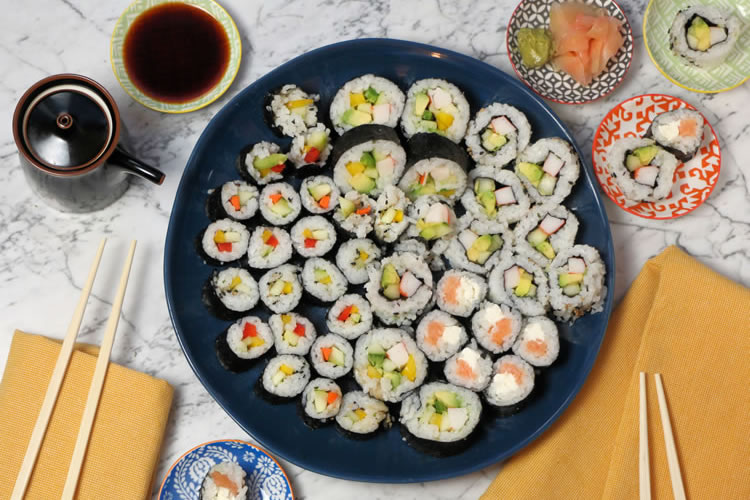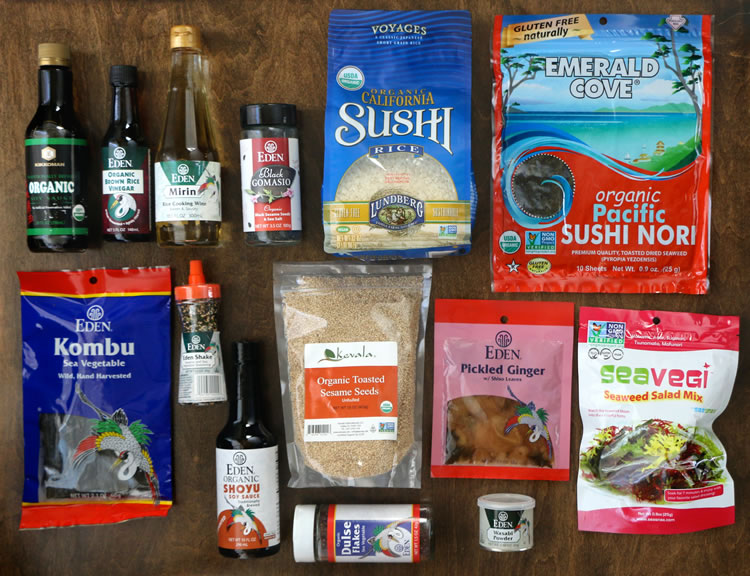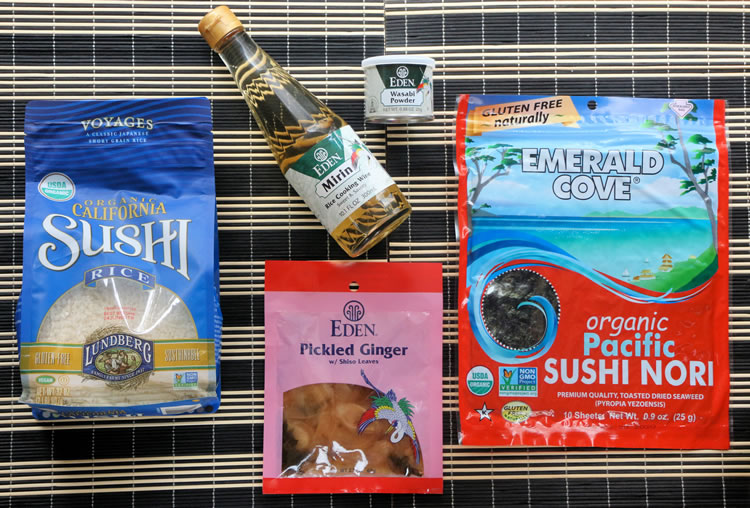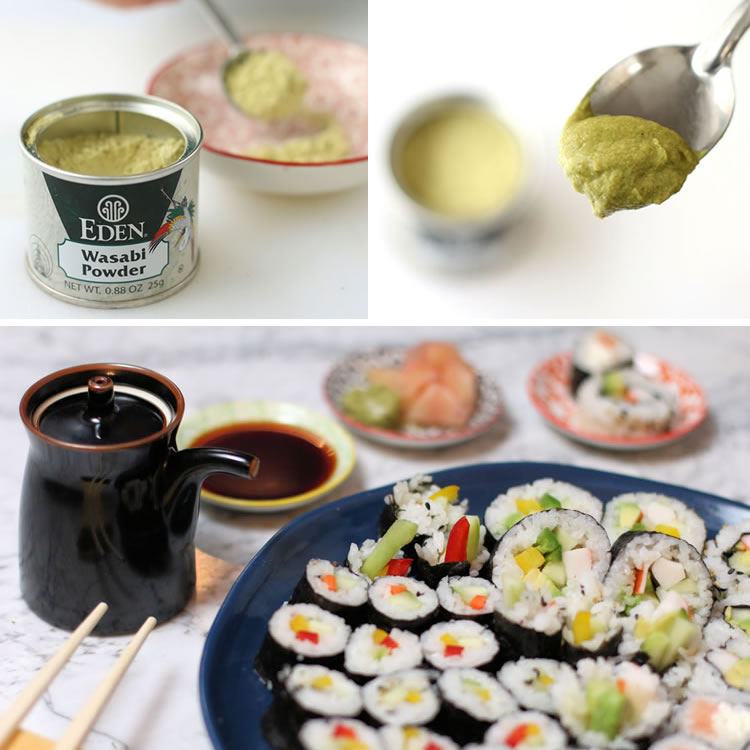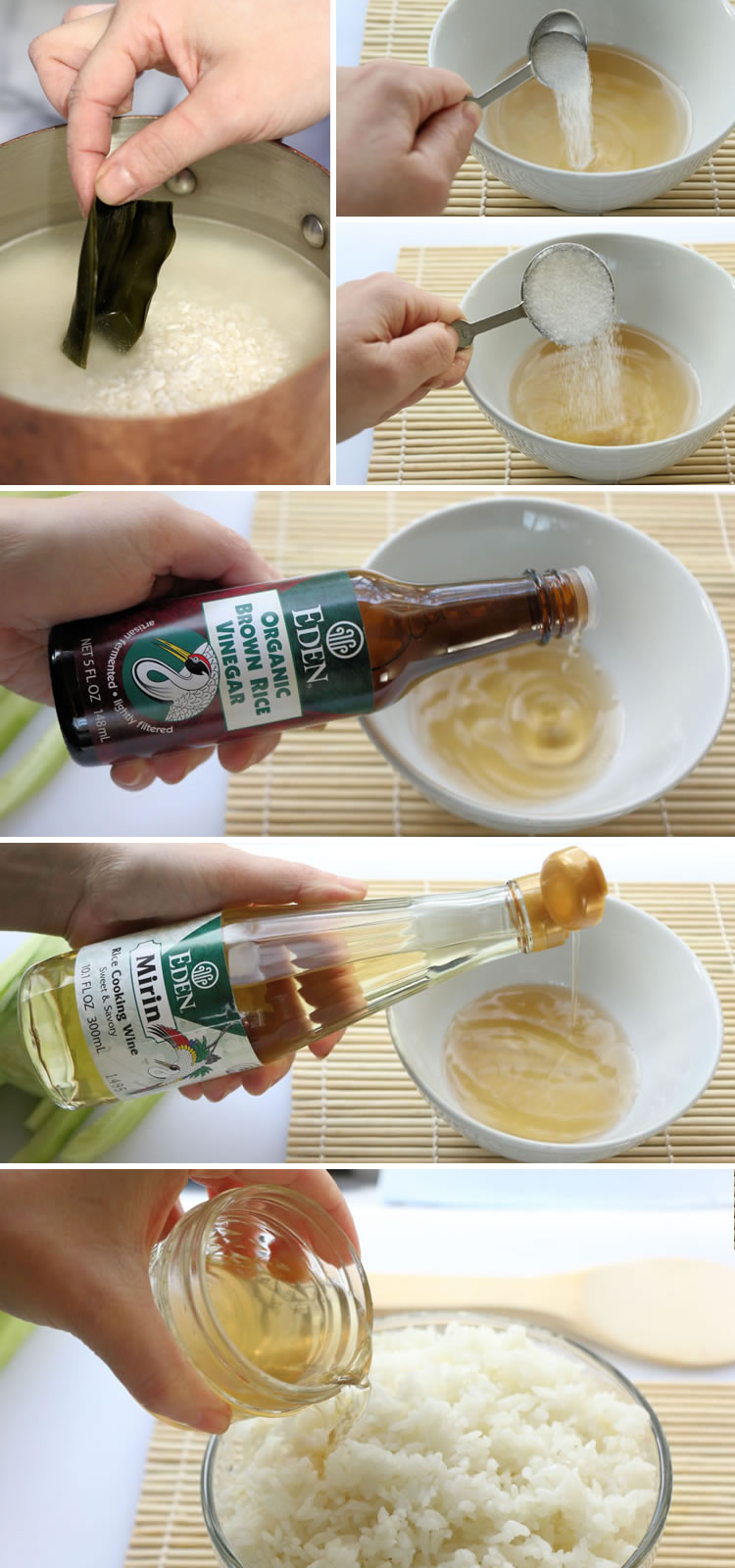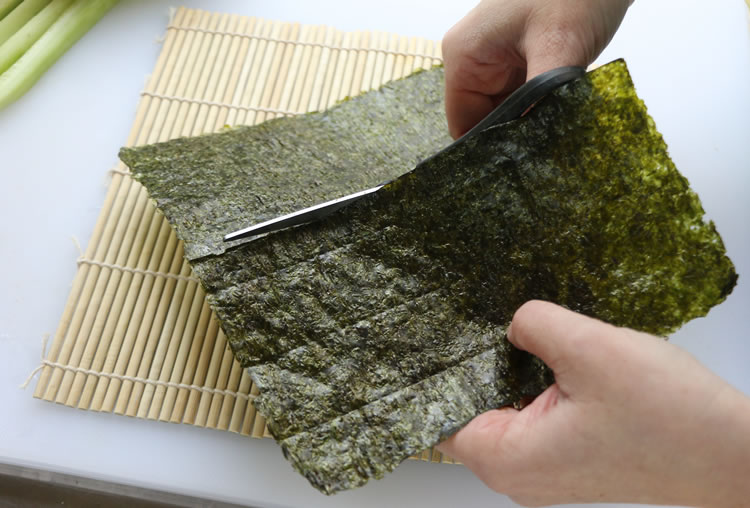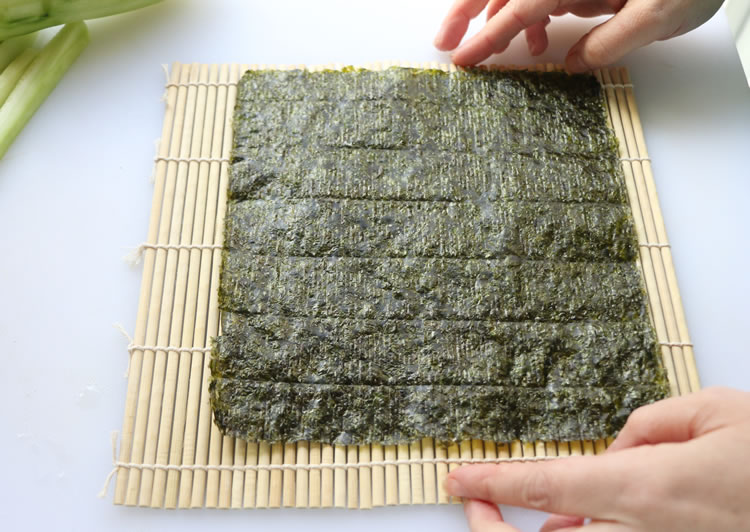* This post is sponsored by iHerb. The opinions and content presented here are my own.
I used to have a pretty bad sushi habit I just couldn’t shake. I would crave it and dream about it, and then something happened. I realized the crazy amount of money I was spending on sushi. Let’s just say it was a lot. Then I thought, “Why can’t I learn to make my own sushi at a home?” I figured I could save some dough and still get all the yummy sushi flavors I crave. And so I did just that. With a little practice, I’m now a sushi-making machine. And you can be one too! I’m going to give you a few tips, tricks and recipes for making some simple sushi rolls at home. Once you get the hang of it, you’ll be whipping up sushi rolls left and right. Then you can surprise and dazzle your holiday guests with a platter of sushi you’ll be delighted to report you made all on your own. Don’t get intimidated because it’s not as hard as it looks. I promise. Here we go…
Gather All Your Ingredients
Don’t call the obvious police on me, but the most important part of making sushi is gathering all your ingredients. Here’s a tip: save time and money by ordering your ingredients from iHerb. They have an awesome selection of Japanese restaurant quality ingredients that you can order all at once and have in just a few days. Most of these products I can’t easily source near me. It would definitely take some fishing around. The only thing left on your list will be the fresh ingredients like fresh veggies, avocado, and fish if you like.
Sushi Rice
If you want your rolls to stick and hold you can’t just use any old rice. You’ll need a short or medium-grain rice with rounder, starchier grains than long-grain types, which just won’t give you the “glue” you need to make your sushi stick. When making your sushi, the rice should be slightly warmed.
Recommended Products:
Lundberg, Organic, California Sushi Rice
Kombu (kelp, optional)
Sushi chefs love adding some of this seaweed known as “the king of seaweeds” to the sushi rice water as it cooks. It adds a slight umami flavor while adding healthy minerals like calcium and iodine which can promote healthy thyroid function. If you’re going for authentic, be sure to pick up this ingredient to make your sushi rice.
Recommended Products:
Eden Foods Kombu
Mirin
Mirin is sweet Japanese style cooking wine made from rice and a common ingredient in Japanese sauce recipes. What does it have to do with sushi? After the sushi rice is cooked it gets seasoned with a sauce called ‘su’ made of mirin, rice wine vinegar, sugar, and salt. It gives the sushi rice a nice tangy zip. It’s a great ingredient to have in your pantry if you love preparing Asian recipes since it’s called for often.
Recommended Products:
Eden Foods Mirin Rice Cooking Wine
Rice Vinegar (rice wine vinegar)
Made from fermenting rice, rice wine vinegar is less acidic than white vinegar and with a slightly sweeter and more delicate flavor. We need this for our ‘su’ – a sauce to season our sushi rice with, but it’s also great for making Asian inspired salad dressings and marinades.
Recommended Products:
Eden Foods, Organic Brown Rice Vinegar
Nori (seaweed sheets)
Nori is the dark green paper-like sheets of seaweed pressed into thin sheets that you use to roll your ingredients into sushi with. The good news is that Nori is super low in calories and is extremely nutritious. It’s high in protein, fiber, vitamins A, vitamin C and B’s as well as and minerals like manganese, phosphorus, iodine, and iron. It’s also a good source of EPA, an omega-3 fatty acid. Be careful because Nori loves to absorb water. After the package is opened, store in an airtight container to protect against moisture. When you’re not making sushi you can enjoy it as a snack.
Recommended Products:
Emerald Cove, Organic Pacific Sushi Nori
Toasted Sesame Seeds (Goma)
Sesame seeds have a lovely toasty flavor and can be used to garnish the inside or outside of your rolls before cutting. These tasty little guys are nutritious too! Sesame seeds are a very good source of manganese, and also provide calcium, phosphorus, magnesium, iron, zinc, molybdenum, vitamin B1, selenium and dietary fiber. Choose from white or black or a combo of both.
Recommended Products:
Organic Black Gomasio Sesame Seeds & Sea Salt
Kevala, Organic Toasted Sesame Seeds
Eden Foods, Eden Shake, Sesame and Sea Vegetable Seasoning OUR FAV!)
Wasabi (Japanese horseradish)
This is a paste made from the ground rhizomes from the wasabi plant that is served alongside your favorite sushi rolls and dishes. Similar in taste to horseradish, wasabi is not for the timid. Did you know that you most likely won’t get authentic wasabi in a restaurant unless you specifically request it? And you might even get charged. In fact, most of the “wasabi” products on the shelves aren’t really wasabi at all – they’re usually made of horseradish. Skip it if it’s too much for your tongue and your sinuses, but for me, wasabi is a sushi must. Fresh wasabi can be challenging to find, but it also comes in tubes or powdered blends that can be rehydrated with just a little warm water. Wasabi is great for the digestive and cardiovascular system, can help fight the effect of arthritis and has anti-cancer properties. So feel free to add a dab when you need a little pick-me-up.
Recommended Product:
Eden Foods Wasabi Powder
Pickled Ginger (‘gari’)
Pickled ginger is served in sushi restaurants a nice palate cleanser between sushi dishes. Ginger is often dyed pink for color but you may find white ginger (undyed) on your travels as well which has the same flavor. Ginger has powerful healing qualities as a remedy for upset stomach and protects the stomach. It also has anti-inflammatory effects, contains potent antioxidants and even protects the liver.
Recommended Products: Eden Foods Pickled Ginger with Shiso Leaves
Soy Sauce (preferably Japanese)
To dip or not to dip, that is the question. While dipping sushi in soy sauce is controversial (some say it’s too overpowering) – I like it and I think most people do too. So which one do you get? Go for a good quality soy sauce that will perfectly complement the subtle flavors of the sushi. My absolute favorite is Eden Foods Organic Shoyu Soy Sauce. Shoyu is a Japanese style soy sauce that is sweeter and milder than its stronger Chinese counterparts. One taste and I was wondering where this was my entire life. Believe me, it’s next level soy sauce. If you’re gluten-free sub the Shoyu for Tamari which is brewed with little to no wheat. Just make sure gluten-free is on the label.
Recommended Products:
Eden Foods, Organic, Shoyu Soy Sauce (Our Top Pick!)
Kikkoman, Organic Soy Sauce
“Sushi-Grade” Fish: The Myth
If you want to dive in right away and use raw fish for your sushi rolls then you get a round of applause. If you think you’re going to be able to get what is called “sushi-grade” fish then I have to throw you a couple of boos. While sushi-grade is a term used to refer to fish that is supposed to be set to a high level of culinary standard, the truth is that there is no one regulating this stuff. The “sushi-grade” police do not exist. Fish is graded by the fish wholesalers and prices are set accordingly.
So what do you do? The best you can do is find a truly reputable and clean fish-monger who you trust. Even super fresh fish can be contaminated if it’s been prepared on the same cutting board or cut with the same knife as a fish that is tainted. If you don’t want to go through the hassle or you feel it’s all a bit sketchy, we’re with you. There’s plenty of other great yummies to fill your sushi with, including cooked or fried shrimp, crab (real or imitation ”krab” ), smoked salmon (it’s safe because it’s cured), all the veggies in the garden, fruits like mango and pineapple and anything else that catches your fancy.
The Tools
There’s a few things you may want to gather to make your sushi making experience a little easier. Plus, once you start making sushi you’re not going to want to stop. Here’s what you’ll need:
A Bamboo Rolling Mat (makisu): This is what you’ll be building the rolls on. It’s then used to roll up your rolls. Got me? This helps to keep all the ingredients together and your rolls nice and taut. They generally measure around 12 x 12 and are really inexpensive (mine was only about $6 and it came with 2 mats and a spoon). You can find them at any Asian market, kitchen store and sometimes in the Asian food aisle of your supermarket. Amazon can set you up too.
Try wrapping yours in plastic wrap to keep the sushi rice from sticking to it and getting stuck in its crevices. This stuff is sticky and it quickly gets messy! I tried it both ways (with and without the plastic) and the plastic wrap way wins. Not loving the whole plastic wrap thing but sometimes you do what you have to do.
A Sharp Knife: When slicing your sushi rolls you must have a sharp knife. You must I say! Seriously though. If your knife is dull it will get caught on the ingredients and you won’t get those nice clean cut pieces. Make your life easier and start sharpening your knife.
Rice Cooker (optional): Many sushi experts prefer to use a rice cooker to cook their sushi rice. They feel it makes the rice perfect and ensures a perfect consistency. They also have a sushi rice setting which makes your cooking life easier. I don’t own a rice cooker and have made sushi rice in a pot several times and haven’t had any issues. At the moment I can’t bear to add another kitchen appliance to my house. If you have a rice cooker great, but if you don’t, no worries. Rice cookers are pretty cheap so if you think sushi making might just be your jam then you might want to buy one. OK, I just talked myself into ordering one. You can also use your Instant Pot!
Instructions For Making The Sushi Rolls
Step1 – Make Your Sushi Rice
The first step in making your sushi rolls is preparing the sushi rice. Sushi rice should be slightly warm when making the sushi rolls.
Measure out the sushi rice you’ll be making (we used 2 cups) and rinse under cool water until the water runs mostly clear. This removes most of the starch from the outside of the rice so it doesn’t turn into a sticky mess. The inside of the rice has just enough starch for what we need. Place in a pot with 2 cups of water and the 2-inch piece of kombu if you have it. If not, it’s okay.
Bring the sushi rice up to a low boil, place the pot lid on and reduce the heat to low. Cook for 15 minutes. Then remove the pot from the heat and let stand for 10 minutes more.
While the rice is cooking prepare the ‘su’ or sushi rice seasoning. In a small bowl mix the mirin, rice wine vinegar, salt, and sugar together. I like to pop it in the microwave for 20 seconds to gently warm it and help the salt and sugar fully dissolve. Give it a good whisk.
After resting you can gently transfer the sushi rice to a glass or ceramic bowl. And then pour the ‘su’ over the sushi rice gently tossing to evenly distribute. Let sit for 5 minutes to let it soak in.
Step 2 – Prepare Your Sushi Fillings
Cut all the fish and veggies of your sushi fillings into long narrow strips or matchsticks aiming for ¼ inch slices. Most fruits, vegetables, greens, and herbs are best rolled raw. Tougher veggies like carrots and asparagus can be blanched. You can include veggies in your sushi like:
- Cucumber
- Avocados
- Bell peppers
- Jalapenos
- Carrots
- Sprouts
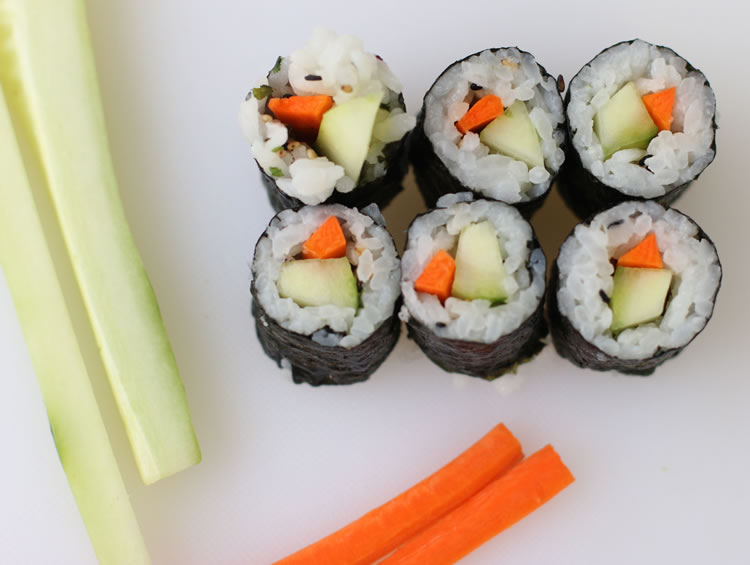
Here are some easy roll ideas to get your feet (or flippers) wet in the sushi making world:
California Rolls: “Krab” (imitation crab), avocado and cucumber
Veggie Roll: your call
Cucumber Roll: cucumber and only cucumber
Philadelphia Roll: smoked salmon, cream cheese
Alaskan Roll: fresh salmon, avocado, cucumber
Tuna Roll: fresh or seared tuna with avocado or cucumber
Step 3 – Cut Your Nori Sheets
You’ll need to cut your nori sheets in half if you want regular maki sized rolls or California rolls. Figure out which is the long side and then fold a crease in that side. Use a scissor to then cut them in half.
Tip: If you like big rolls then go for a full sheet. But you ‘ll need to add plenty of ingredients to make up for the size.
Step 4 – The Moment of Truth – Sushi Rolling Time!
If using a bamboo sushi mat, now’s the time to cover it with plastic wrap. This will keep your rice from sticking. It can get pretty messy. I like to place mine over a large cutting board so I can quickly slice it right there.
Place a half nori sheet shiny side down on the bamboo mat. And then:
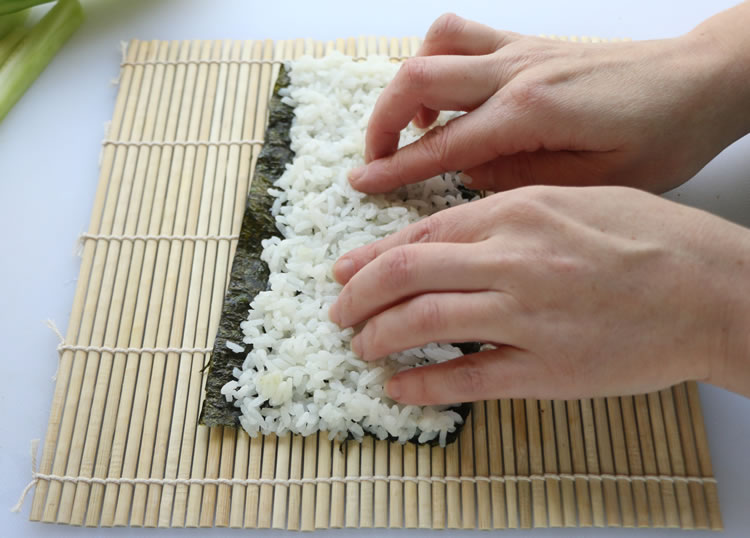
To Make A California Roll or Inside Out Roll (Rice On The Outside)
Moisten your hands and scoop a handful of rice (here’s where that bowl of water comes in handy), onto the nori. Then gently spread and press the rice to spread on the nori evenly covering all the way to the edges.
Not too thick. Sprinkle the rice with sesame seeds and flip over.
Line up just above the bottom edge of the mat. Take a “Krab” stick and slice it in half long ways. Lay it about ⅓ the way down on the nori sheet closest to you. The ingredients should be built parallel to you.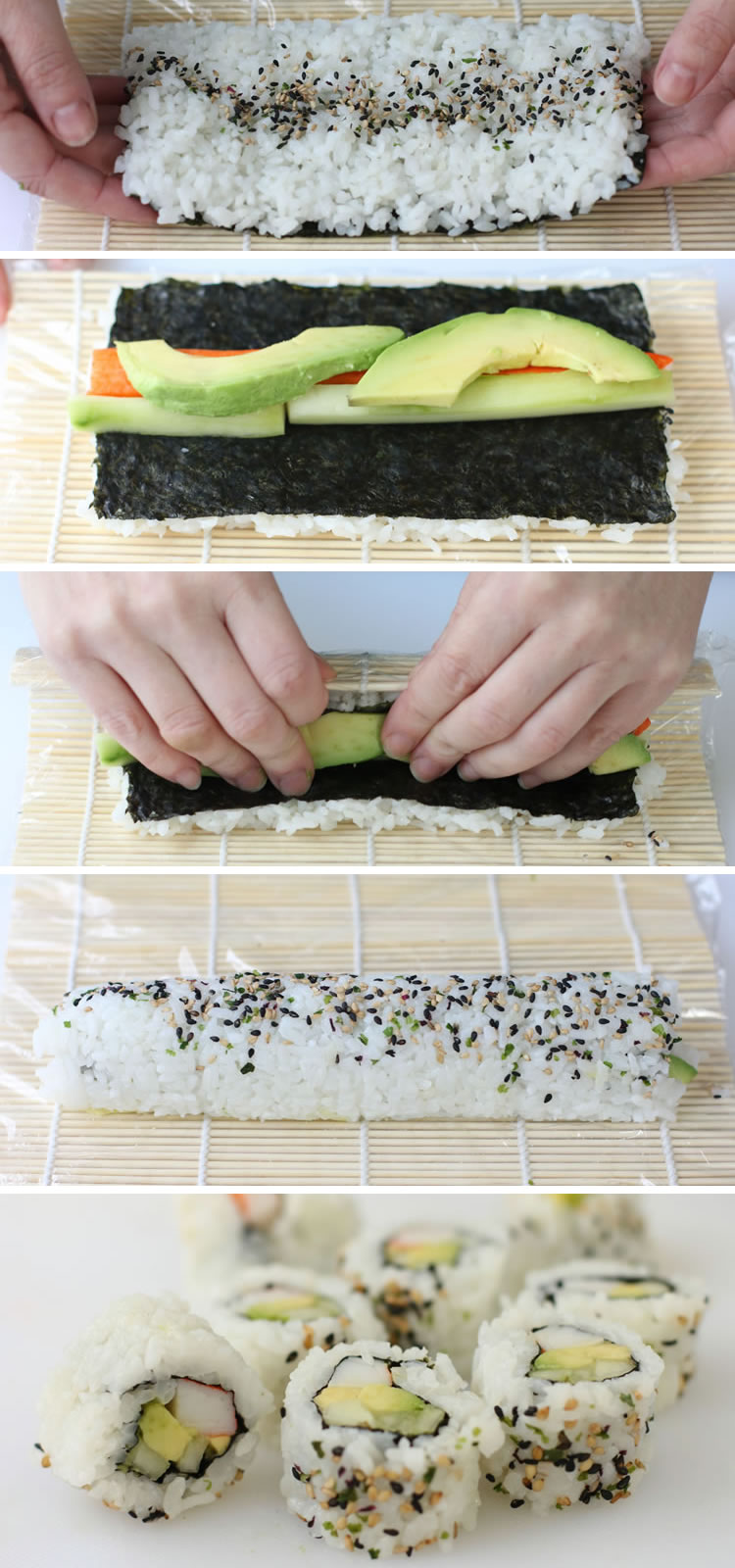
Rolling The Sushi
Using your fingers to hold in the ingredients to your front, start to bring up the bamboo mat, rolling the nori sheet away from you, tucking in the ingredients as you go. Lift the edge from under the roll as you go.
– With a gentle but firm hand, roll up the sushi making sure it’s tightly packed. Unroll the mat and you have your first sushi roll!
To Slice: Dipping your knife in the bowl of water between slices, cut the sushi roll in half. Line those pieces up alongside each other and slice again. Do it twice more and you have evenly sliced sushi pieces.
To Plate and Serve: Move to a plate and serve with Shoyu soy sauce, wasabi, and pickled ginger.
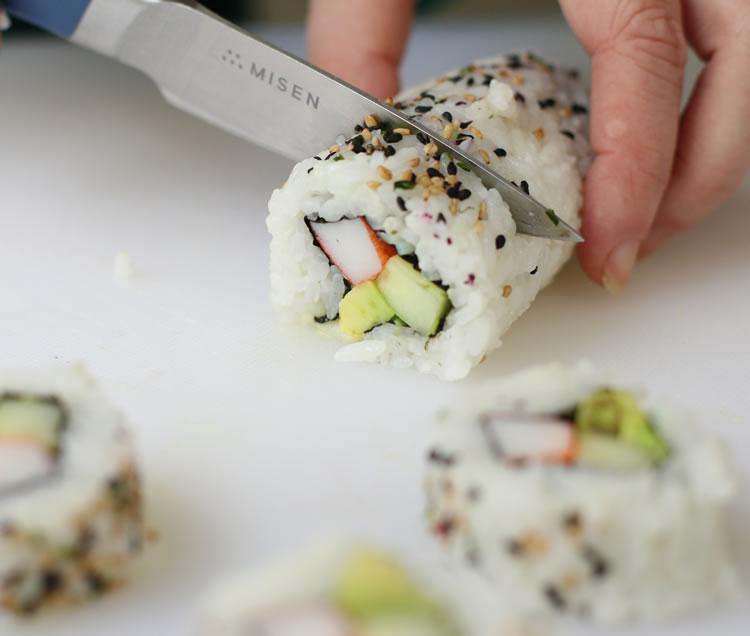
Sushi Cutting Tip: A super sharp knife will make cutting your rolls seamless and easy. But after a slice or two, the rice can still stick. Have a bowl of water nearby to dip your knife into between slices. Your rolls will cut like butter making for a better presentation.

How To Make Maki Sushi (Seaweed/Nori On The Outside)
Place another nori half sheet on the bamboo mat shiny side down.
Spread and press the rice down gently but firmly over the nori sheet. This time leave a gap of rice about ½ inch wide along the long edge of the nori sheet farthest from you. This will help seal the roll.
Place the ingredients across the long side of the rice, about ⅓ the way across the center of the rice but closest to you (opposite the raw seaweed edge). Be careful not to add too many ingredients or you’ll have trouble rolling.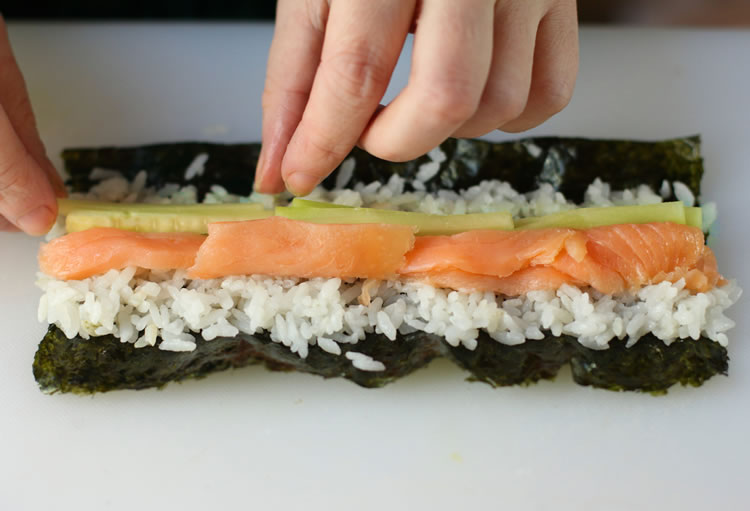
Season with sesame seeds if you like.
Roll as you did the California style roll. Slice like before and then serve with your favorite condiments like soy sauce, wasabi, and ginger.
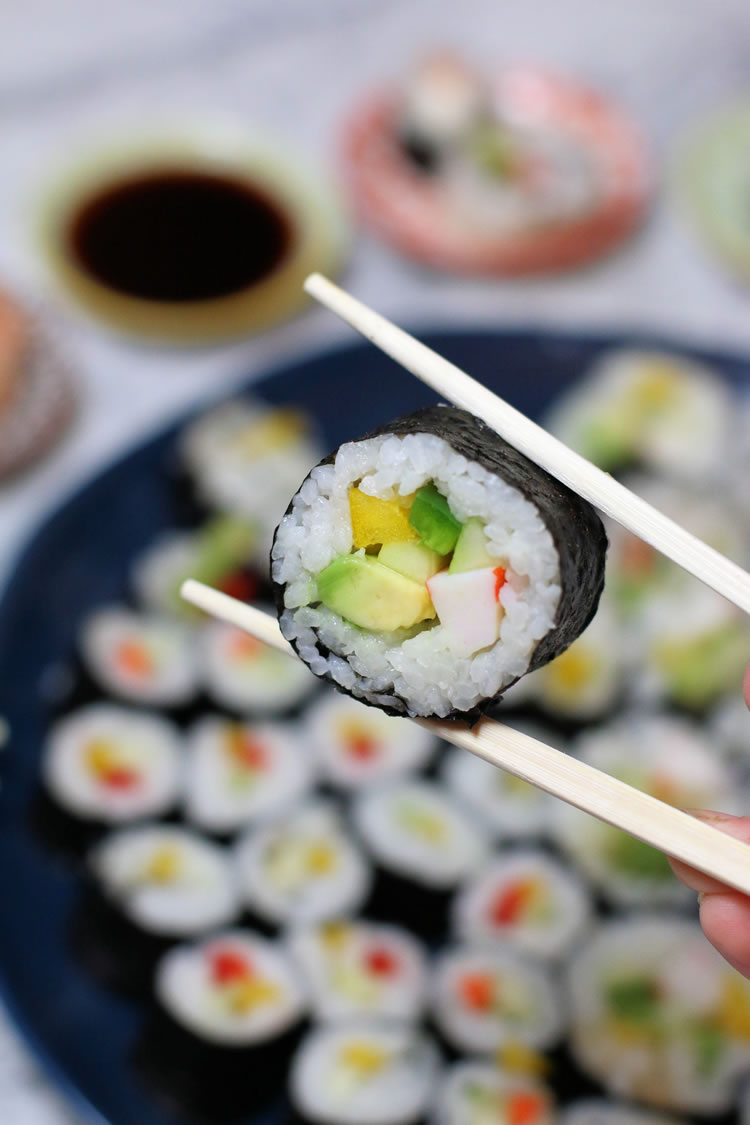
Get The Recipe!
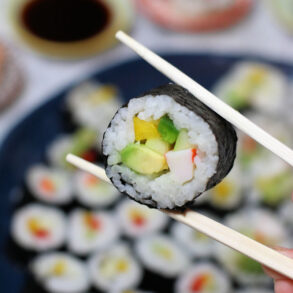
Easy Sushi Rolls
Ingredients
- 1 package Nori, seaweed sheets, cut in half
MAKING THE SUSHI RICE
- 2 cups sushi rice, rinsed until water is mostly clear
- 4 tablespoons rice wine vinegar
- 2 tablespoons mirin
- 2 tablespoons sugar
- 2 teaspoons salt
SUSHI FILLING INGREDIENTS (suggested)
- Imitation Crab Sticks ("krab), cut in half longways
- raw fish, best quality - salmon or tuna cut into long 1/4" slices
- smoked salmon, 1/2 " slices cut longways
- cream cheese, 1/4 " slices
- English cucumber, English cucumber, peeled and cut into 1/4" matchsticks
- avocado, cut into slices
- carrot, peeled, halved and cut into 1/4 " matchsticks
- red or yellow bell pepper, cut into 1/4 " slices
- jalapeno, seeds removed, and cut into 1/4 " slices
Serving Suggestions
- soy sauce, preferably Japanese Style - Shoyu
- toasted sesame seeds, white or black, for sprinkling
- wasabi
- pickled ginger
Tools
- bamboo rolling mat, covered with plastic wrap
DIRECTIONS
Making The Sushi Rice
- Place in a pot with 2 cups of water and the 2-inch piece of kombu if you have it. If not, it's okay. Bring the sushi rice up to a low boil, place the pot lid on and reduce the heat to low. Cook for 15 minutes. Then remove the pot from the heat and let stand for 10 minutes. Transfer to a glass bowl. Sushi rice should be slightly warm when making the sushi rolls.
- While the rice is cooking prepare the ‘su’ or sushi rice seasoning. In a small bowl mix the mirin, rice wine vinegar, salt, and sugar together. Pop it in the microwave for 20-30 seconds to gently warm it and help the salt and sugar fully dissolve. Give it a good whisk. Pour over the rice when done, lightly tossing to coat. Let sit for 5 minutes to let it soak in. The rice is ready for the rolls.
Directions For Maki-Style Sushi (Seaweed Outside/Rice Inside)
- Place the nori sheet on the bamboo mat shiny side down, long side parallel to your body. With damp hands, scoop a handful of rice and gently spread the cooled rice in an even layer over the nori sheet, pressing lightly, leaving the top inch of the nori bare.
- Sprinkle the rice with the toasted sesame seed. Lay the roll ingredients of your choice horizontally across the bottom third of the rice. Continue with rolling directions...
Directions For Inside-Out Style Sushi (California Roll/Rice On Outside)
- Place the nori sheet on the bamboo mat shiny side down, long side parallel to your body. Moisten your hands and scoop a handful of rice (here’s where that bowl of water comes in handy), onto the nori. Then gently spread and press the rice to spread on the nori evenly covering all the way to the edges.
- Sprinkle the rice with sesame seeds and flip over. Take a “Krab” stick and lay it about ⅓ the way down on the nori sheet closest to you following with the avocado and cucumber. Continue with rolling directions...
Rolling The Sushi
- Using your fingers to hold in the ingredients to your front, start to bring up the bamboo mat, rolling the nori sheet away from you, tucking in the ingredients as you go. Lift the edge from under the roll as you go. With a gentle but firm hand, roll up the sushi making sure it’s tightly packed
Slicing The Sushi
- Dipping a sharp knife in a bowl of water between slices, cut the sushi roll in half. Line those pieces up alongside each other and slice again. Do it twice more and you have evenly sliced sushi pieces.
Serving The Sushi
- To Plate and Serve, Transfer the roll to a plate and serve with Shoyu soy sauce, wasabi, and pickled ginger.
Get all your sushi making ingredients at iHerb!
We love shopping at iHerb! Their prices are amazing, they ship quickly and you can even earn rewards!
Did you know…???
iHerb sells over 30,000 products!
iHerb ships to over 150 countries!
iHerb is a Google Trusted Store and their customer service team provides support in 10 different languages!
Like Saving Money? Me Too! Here’s A Special iHerb Offer:
Customers can get a discount off their iHerb order and NEW customers can get an additional $5 OFF their minimum $40 ORDER by clicking here!
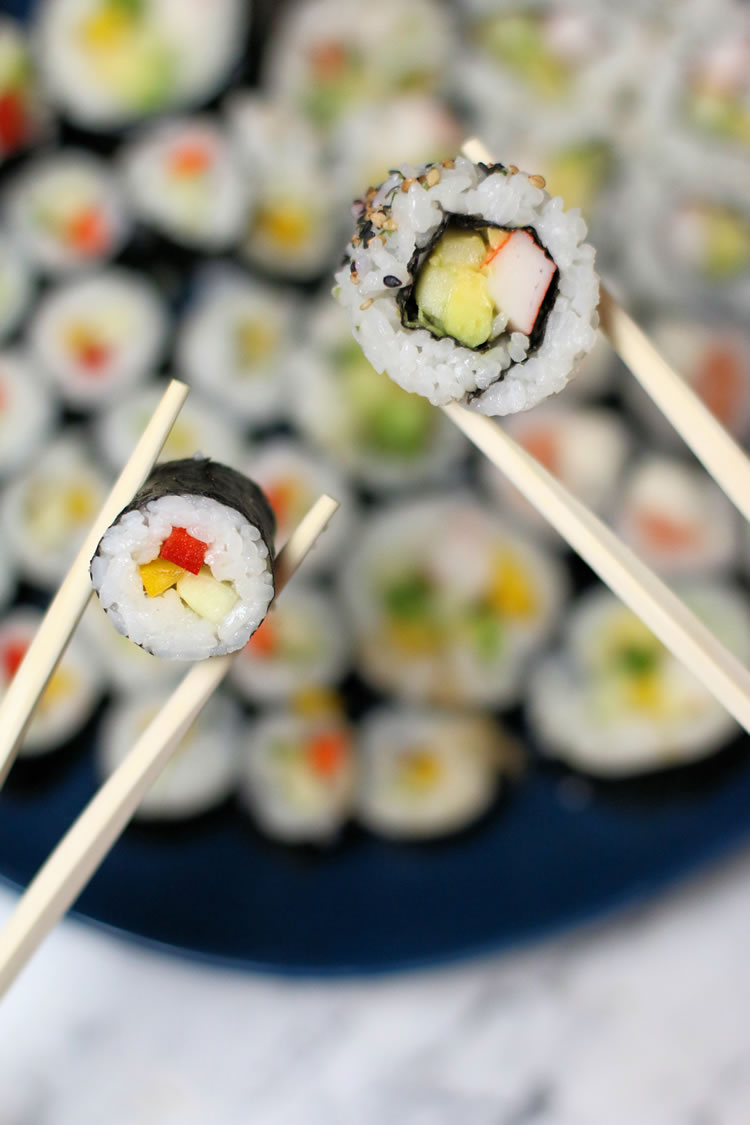
Better Living uses affiliate links. If you make a purchase through them, we may receive a small commission (for which we are deeply grateful) at no cost to you.

